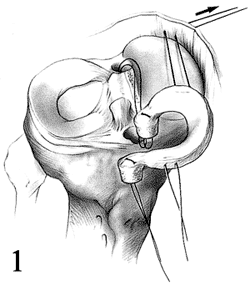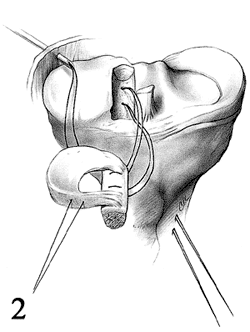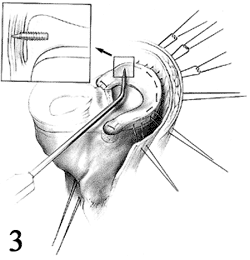Meniscal allograft transplantation: When and how to proceed
Chief medical editor interviews Marlowe Goble, MD, on this controversial procedure.
I am introducing this month the first interview in an occasional series with experienced surgeons about specific orthopedic procedures. The first interview with Marlowe Goble, MD, of Logan, Utah, is on meniscal allograft transplantation, a procedure that is embraced by some and never considered by others. His experience and insight is presented to help you/us minimize possible complications and help with patient selection factors.
— Douglas W. Jackson, MD
Chief Medical Editor
|
|
Jackson: What is your preferred surgical technique and reason for selecting it?
Goble: I prefer implanting a MAT utilizing bone plugs (bone island) to fix the MAT to the host tibia. Multiple investigators performing MAT have reported similar good results when bone plugs were used for anterior and posterior horn anchors, as well as sewing the periphery. The technique, standardized between 1989 and 1999, was extremely difficult to reproduce. Surgeons, therefore, looked for acceptable alternatives because of the difficulty, mostly involving implantation of the bony plugs.
This led to insertion of the allograft meniscus without bony attachments. Freddie Fu and others reported good results by installing the MAT in such a fashion. The elimination of bony attachments to the meniscal allograft has been the major change.
I have not found this to be acceptable. Installing bony plugs into the anterior and posterior horns of the menisci, however difficult, ensures anatomic anchoring to the tibia to allow the longitudinally oriented (hoop stress) cartilage to function properly (figure 1). When one eliminates the bony plugs, one is then depending upon the proper attachment of the MAT to the remaining periphery. This periphery may or may not have sufficient attachments to the native posterior horn, and even if it does, the neck of the soft-tissue portion of the graft may not properly insert itself into what is left of the horn of the native meniscus.
The standard approach for a lateral MAT is a bone island joining the anterior and posterior horns placed within a trough or keyhole (figure 2). This has become a standardized and reproducible procedure. The medial meniscus installation presents the most difficult surgical technique. A bony island between the anterior and posterior horns of the medial meniscus represents a rather long connection and is subject to complications. Separating the two horns still remains the technique of choice, and anatomical placement of the two horns is essential.
|
COURTESY OF MARLOWE GOBLE |
Jackson: What about the time required for the surgery?
Goble: I am aware of the time factor and the difficulty of arthroscopic insertion of a MAT, but I am not convinced that the boneless MAT is worth the effort. Just because something is easier to perform does not necessarily justify using it.
We have learned from second-look arthroscopies that a MAT will heal to the periphery of the host in about six weeks with only six to eight peripheral (mattress) sutures (figure 3). I think this has contributed much to our understanding of the repair of bucket-handle tears in that we do not go to the same meticulous lengths to repair meniscal tears since we have learned that anatomic apposition with few properly placed sutures may be sufficient.
Currently, a medial MAT requires two hours for completion; a lateral MAT can be completed in 90 minutes.
Jackson: What have you learned about sizing the meniscal allograft?
Goble: Sizing continues to be a real concern. The numbers are not sufficient to draw conclusions, but most experienced MAT surgeons always oversize the meniscus, at least in the anteroposterior plane and ideally by 1 mm to 2 mm in the mediolateral plane. Some adjustment can be made surgically for an oversized meniscus (minimally so), but it is impossible for an undersized meniscus to survive condylar weight-bearing in compression. The height and girth match is unreasonable to expect in present-day allograft inventory limitations.
Jackson: Is there a place for an open MAT?
Goble: An open technique especially for medial meniscal insertion is acceptable. Sometimes the repair can be performed more accurately in an open situation with a medial epicondylar osteotomy, and this does not prevent outpatient status and early rehabilitation. It is important to choose either an open procedure or an arthroscopic procedure based on anatomical installation, not on the size of the incision or approach. Meniscal allograft transplantation is an important and major procedure. It should not be treated like a native meniscal resection or standard arthroscopy. The outcome should dictate the surgical approach.
Jackson: What are your current indications for MAT?
Goble: Indications include skeletal maturity; 0-3 outer bridge articular cartilage changes; proper femorotibial alignment within 2º of the opposite normal side; stable joint; abnormal signs and symptoms of compartment changes occurring; complaints of pain and swelling with activities; at least one second opinion; and an active or demanding lifestyle. Low-demand patients are candidates for change of activities or salvage procedures.
Jackson: What type and processing of the meniscal transplant do you use?
Goble: The meniscal allograft transplantation study began in 1989, supported by CryoLife Inc. Almost all of my experience has been with cryo- preserved meniscal allografts. It is my belief that although few donor cells survive in the transplant, the meticulous method of preservation, freezing and slow thawing — thus possibly avoiding crystal formations within cells and matrix — help preserve the integrity of the graft.
Currently, however, I am using fresh frozen allografts. Short-term follow-up shows no difference. My experience with fresh frozen has only a one-year follow-up. I have no experience with the use of freeze-dried allografts. I do not transplant grafts that have been irradiated. I also do not install allografts from donors over age 35. I feel that degenerative changes begin in native menisci at approximately age 35, and I see no reason to transplant a graft that has begun to degenerate.
Jackson: What complications have you seen?
Goble: I have experienced one complication with an intraluminal injury of the popliteal vein caused at the time of removal of the posterior horn of the lateral meniscus.
- Bicompartmental transplantation. The medial meniscus was sized to fit properly; however, the lateral meniscus (from the same donor) was 2 mm too small in the mediolateral plane. Predictably, the lateral side failed. It is a proper precaution to try not to mix transplants and size each compartment separately. However, one cannot assume that if the medial compartment is the proper size that the lateral size will also be. It is better to transplant menisci from separate donors than to mis-size the transplant.
- Post transplantation separation of the posterior horn of medial meniscal transplant. It is difficult to implant the posterior horn and also just to sew the posterior horn to its intended capsule. It seems that if failure will occur, it will occur in the posterior horn area. I believe this is because of the function of the medial meniscus as a secondary restraint to rotational and anterior translation. Firm fixation posteriorly and proper fit are essential for survival.
- Transplantation in a relatively asymptomatic patient. I was referred a young patient who had a transplantation performed in anticipation of problems. He came to me because of pain and catching (but no swelling) in the lateral compartment. The patient felt he was worse; however, he has no way of knowing what his situation would have been having not had any transplantation.
- Shrinkage. The amount of shrinkage in the girth of a meniscus is difficult to anticipate. In second-look procedures, which I performed in the early 1990s, shrinkage of some degree would occur in about 50% of patients. This did not, however, correlate with poor results. The numbers were few, and I do not think that conclusions can be drawn. But, one should anticipate that the meniscus may not remain the same size as is implanted. This is one of the reasons that I oversize by 2 to 3 mm.
Jackson: What have you learned from the follow-up on your patients?
Goble: In my practice, the average age of patients receiving ACL reconstruction is 24 years; the average age of patients receiving total knee replacement is 64 years. Those patients receiving MAT average 38 years. The relatively young age of MAT patients puts them in the category of high-demand working age, recreational and/or athletic patients. I have found that these patients are extremely appreciative of good short-term results as long as they understand the limitation in advance.
Early in the study I placed MATs in grade 4 patients, and all of these failed within four years. However, in almost all cases there was decrease in pain and swelling, even in these grade 4 situations. These patients were extremely appreciative for the two to four years they experienced good function. Similarly, patients with grade 2 and 3 changes, who experienced mostly survival of the graft greater than five years, never complained about subsequent tears (15%) and total failure (6%) of their graft. Instead, they focused on the good results and their ability to recreate with their families and participate in their relatively high-demand activities as a very positive experience. Some patients underwent a second MAT because of the good short-term results.
What this tells me is that although the medical community may consider 70% to 80% of good and excellent results as almost a failure of the procedure, patients rate their experience as a success at the 96% level. This is not just my experience, but it is the experience of many other investigators.
The acceptance of short-term results in high-demand working-age people should teach us that MAT or even prosthetic replacements with short-term life spans may be acceptable and be considered a medical success.
We used to think that whatever we do has to have 90% good and excellent results and long-term survival for the procedure to be beneficial. MAT has taught us differently. Investigators looking into solutions to meniscal failures — whether it be scaffoldings, transplants or prosthetics — should keep in mind the above experience.




